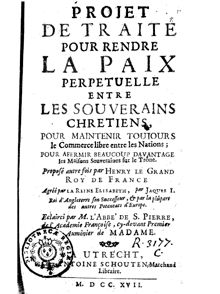

| Visitors Now: | |
| Total Visits: | |
| Total Stories: |

| Story Views | |
| Now: | |
| Last Hour: | |
| Last 24 Hours: | |
| Total: | |
The Plan For A New World Order Stumbles On Geopolitical Realities
For four centuries, political leaders have tried to create an international order that governs relationships between nations and prevents wars. While the principle of state sovereignty has yielded results, intergovernmental organizations have mainly reflected the prevailing balance of power. As for the ambitious U.S. New World Order, it is being shattered by new geopolitical realities.
The slow formation of an international order
The idea of a world or international order appeared in the seventeenth century, although the phrase “world order” has been introduced only recently in political discourse. It was discussed whenever an opportunity presented itself to organize and sustain peace.
It was in 1603 that King Henri IV of France had his minister, the Duc de Sully, develop a first draft. The objective was to constitute a Christian republic including all the peoples of Europe. It would have ensured the preservation of nationalities and religions and been responsible for resolving problems between them.
The Grand Design stipulated the redefinition of state boundaries to balance their power, the creation of a European confederation of 15 with a supranational Council with the power of arbitration and an army capable of protecting the confederacy against the Turks.
However that dream was interrupted by the assassination of Henri IV and resurfaced only at the end of the wars launched by Louis XIV. The Abbot of Saint-Pierre published his Project for perpetual peace among the Christian rulers.
The plan, which was presented to the Congress of Utrecht (1713), consisted in adopting in full all the decisions taken at that conference as the basis for the determination of the borders between the belligerent countries, and the establishment of a league of European nations (International Federation) whose mission was to prevent conflicts.
Apart from this utopia, and more important at the time, there were the Peace Treaties of Westphalia, signed in 1648. They intervened at the end of a Thirty Years’ War, conducted under religious banners, resulting in an accumulation of hatred and in the destruction of 40% of the population.
The negotiations lasted four years (1644-1648). Ultimately, they enshrined the principle of equality in negotiations between all parties in conflict, whether Catholic or Protestant, republican or monarchical.
The Treaty of Westphalia laid down four fundamental principles:
![]() 1. The absolute sovereignty of the nation-state, and the fundamental right to political self-determination.
1. The absolute sovereignty of the nation-state, and the fundamental right to political self-determination.
![]() 2. Legal equality between nation-states. The smallest state is, therefore, equal to the largest, regardless of its weakness or its strength, its wealth or poverty.
2. Legal equality between nation-states. The smallest state is, therefore, equal to the largest, regardless of its weakness or its strength, its wealth or poverty.
![]() 3. Compliance with treaties, and the emergence of binding international law.
3. Compliance with treaties, and the emergence of binding international law.
![]() 4. Non-interference in the internal affairs of other states.
4. Non-interference in the internal affairs of other states.




